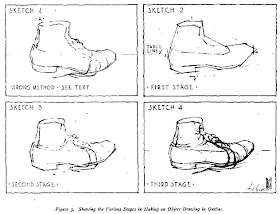
The upper left drawing, labelled as the “wrong method,” shows the outline drawn around the outside edge of the form, starting at “A,” The pencil moves slowly along the edge to record every bump and undulation.
The method resembles the “contour drawing” approach recommended years later by Kimon Nicolaides in the influential 1941 book The Natural Way to Draw. The contour method was almost universally taught at the high school and college level when I was in school, and is still recommended by some teachers, especially as a way to help a developing artist to experience right-brain perception.
What’s wrong with that method? The result looks pretty good, but they're only going to be perfect in very experienced hands (see अर्जुन's anecdote after yesterday's post).
Guptill says the problem lies in the judgment of proportions: “However careful one may be in drawing each small portion as he goes along, the larger forms are almost sure to be wrong, which in turns means that the smaller proportions are wrong, too, in relation to one another."
In the case of the shoe, Guptill says, the ankle is too thick, the sole is to low compared to the heel, and the toe doesn’t point up high enough. These inaccuracies may not be a big deal with a shoe, but if they occur in a person’s face, the results will be disturbing.
So what’s the right method, according to Guptill? Instead of fixating right away on the little bumps and wrinkles, the artist should look for the big shapes and relationships first. The right method is to measure the slopes, check the vertical alignments, and double-check the proportional measurements. The small details like the wrinkles and laces are seen in relation to the big shapes. But the foundation must be right first.
Download Guptill’s copyright-free book from Google.
Thanks, Matt!

Great share! Thank you. I'm going to go through this book asap.
ReplyDeleteThanks for sharing! The 'right' method is the way I'm being taught to draw in school, so it seems as if Guptill's influence runs long. In fact, contour is only whispered about in hallways, hell awaits any student caught doing it!
ReplyDeleteThat is VERY interesting. I was taught the contour method of drawing in school in the 60's. What we did was to draw without looking at the page, only at the model, and what appeared on the page was pretty mixed up, except that it did have the sort of essence of the thing or person we were drawing.
ReplyDeleteThe problem came later when I was trying to draw realistically. It has been an ongoing problem actually--getting all the parts in the right relationship to each other. It is especially difficult when drawing from life a scene with a number of disparate parts: a table with chairs, for example, or a group of houses. I never learned how to get all the parts in exactly the same scale, and just a degree or two of difference can throw the whole thing off.
Why choose? One should be required to learn both.
ReplyDeleteOf course you are absolutely right in saying that one cannot count on contour drawing for accurate global proportions, so it is absurd to teach it as the only method, if you are at all interested in realism. But it also has uses that cannot be supplied by a measurement based top-down method. I often use it for poses too fleeting to be measured, or to "feel" the small curves of a form, or to get a first idea of a form before starting a top-down approach, or simply to make a globally innacurate but pleasing line drawing. So, if you only learn one method, by all means learn top-down proportional methods or triangulation or whatever equivalent. But really, why would you want to learn only one method?
Also, I have no problem with saying "this is wrong" or "this is right", but I find that adding adding "...for the following purpose" sometimes is all it takes to clear up apparent polemics and contradictions.
I call this "blocking".
ReplyDeleteAfter your object is blocked in with correct proportions and angles, you can "build" the contours upon it.
What's cool is blind contour drawing that sensitizescultroto your eye to contours and coordinate that sensitivity with your drawing hand.
I didn't know you had a blog! :D I shall certainly be watching this space. ^___^
ReplyDeleteAnd my second thought - 'Guptill' as in Watson-Guptill? I looked it up, and Arthur Guptill was indeed one of the founders. Wow!
Elinor, yes, Guptill was a good friend of Watson, and they not only formed the publishing house, but also Art Instruction magazine, which later became American Artist.
ReplyDeleteDavid and Antonio, I tend to agree with you. I don't think of any art methods as "right" or "wrong," so much as "useful" or "not useful," depending on what goals and purposes one is setting out to achieve.
What is interesting to me is how similar Guptill's method is to the Brague Drawing course. Using straight lines and measuring angles and proportions and looking at the shapes and not trying to copy what your eye sees.
ReplyDeleteInteresting, his "correct" method was taught when I was doing life drawing in one class, but another used the contour drawings as a warmup, as well as mixing them with other types
ReplyDeleteGoogle seems to have removed the book, but it's still available at http://www.archive.org/details/sketchingrenderi00guptuoft (I think someone claimed it was still in copyright, as they say that's why it's restricted)